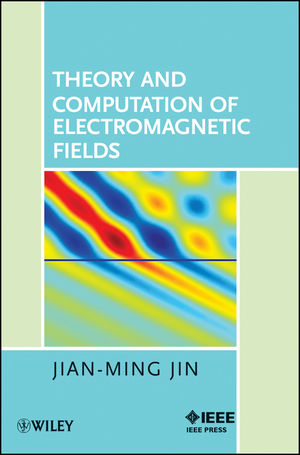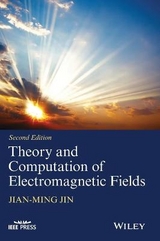
Theory and Computation of Electromagnetic Fields
Wiley-Blackwell (Verlag)
978-0-470-53359-8 (ISBN)
- Titel ist leider vergriffen;
keine Neuauflage - Artikel merken
New graduate students come to take the graduate electromagnetics course with a significant difference in their knowledge of basic electromagnetic theory. To meet the challenge to benefit all students of backgrounds, this book covers both fundamental theories, such as vector analysis, Maxwell's equations and boundary conditions, and transmission line theory, and advanced topics, such as wave transformation, addition theorems, and scattering by a layered sphere.
Jian-ming Jin, PhD, is Y. T. Lo Chair Professor in Electrical and Computer Engineering and Director of the Electromagnetics Laboratory and Center for Computational Electromagnetics at the University of Illinois at Urbana-Champaign. He authored The Finite Element Method in Electromagnetics (Wiley) and Electromagnetic Analysis and Design in Magnetic Resonance Imaging; coauthored Computation of Special Functions (Wiley) and Finite Element Analysis of Antennas and Arrays (Wiley); and coedited Fast and Efficient Algorithms in Computational Electromagnetics. A Fellow of IEEE, he is listed by ISI as among the world's most cited authors.
PREFACE. ACKNOWLEDGMENTS. PART I ELECTROMAGNETIC FIELD THEORY. CHAPTER 1 BASIC ELECTROMAGNETIC THEORY. 1.1 Review of Vector Analysis. 1.1.1 Vector Operations and Integral Theorems. 1.1.2 Symbolic Vector Method. 1.1.3 Helmholtz Decomposition Theorem. 1.1.4 Green's Theorems. 1.2 Maxwell s Equations in Terms of Total Charges and Currents. 1.2.1 Maxwell s Equations in Integral Form. 1.2.2 Maxwell s Equations in Differential Form. 1.2.3 Current Continuity Equation. 1.2.4 The Lorentz Force Law. 1.3 Constitutive Relations. 1.3.1 Electric Polarization. 1.3.2 Magnetization. 1.3.3 Electric Conduction. 1.3.4 Classifi cation of Media. 1.4 Maxwell s Equations in Terms of Free Charges and Currents. 1.5 Boundary Conditions. 1.6 Energy, Power, and Poynting's Theorem. 1.7 Time-Harmonic Fields. 1.7.1 Time-Harmonic Fields. 1.7.2 Fourier Transforms. 1.7.3 Complex Power. 1.7.4 Complex Permittivity and Permeability. CHAPTER 2 ELECTROMAGNETIC RADIATION IN FREE SPACE. 2.1 Scalar and Vector Potentials. 2.1.1 Static Fields. 2.1.2 Time-Harmonic Fields and the Lorenz Gauge Condition. 2.2 Solution of Vector Potentials in Free Space. 2.2.1 Delta Function and Green's Function. 2.2.2 Green s Function in Free Space. 2.2.3 Field Source Relations in Free Space. 2.2.4 Why Use Auxiliary Potential Functions. 2.2.5 Free-Space Dyadic Green's Functions. 2.3 Electromagnetic Radiation in Free Space. 2.3.1 Infi nitesimal Electric Dipole. 2.3.2 Finite Electric Dipole. 2.3.3 Far-Field Approximation and the Sommerfeld Radiation Condition. 2.3.4 Circular Current Loop and Magnetic Dipole. 2.4 Radiation by Surface Currents and Phased Arrays. 2.4.1 Radiation by a Surface Current. 2.4.2 Radiation by a Phased Array. CHAPTER 3 ELECTROMAGNETIC THEOREMS AND PRINCIPLES. 3.1 Uniqueness Theorem. 3.2 Image Theory. 3.2.1 Basic Image Theory. 3.2.2 Half-Space Field Source Relations. 3.3 Reciprocity Theorems. 3.3.1 General Reciprocity Theorem. 3.3.2 Lorentz Reciprocity Theorem. 3.3.3 Rayleigh Carson Reciprocity Theorem. 3.4 Equivalence Principles. 3.4.1 Surface Equivalence Principle. 3.4.2 Application to Scattering by a Conducting Object. 3.4.3 Application to Scattering by a Dielectric Object. 3.4.4 Volume Equivalence Principle. 3.5 Duality Principle. 3.6 Aperture Radiation and Scattering. 3.6.1 Equivalent Problems. 3.6.2 Babinet's Principle. 3.6.3 Complementary Antennas. CHAPTER 4 TRANSMISSION LINES AND PLANE WAVES. 4.1 Transmission Line Theory. 4.1.1 Governing Differential Equations and General Solutions. 4.1.2 Refl ection and Transmission. 4.1.3 Green s Function and Eigenfunction Expansion. 4.2 Wave Equations and General Solutions. 4.2.1 Wave Equations and Solution by Separation of Variables. 4.2.2 Characteristics of a Plane Wave. 4.2.3 Wave Velocities and Attenuation. 4.2.4 Linear, Circular, and Elliptical Polarizations. 4.2.5 Wave Propagation in Metamaterials. 4.3 Plane Waves Generated by A Current Sheet. 4.4 Refl ection and Transmission. 4.4.1 Refl ection and Transmission at Normal Incidence. 4.4.2 Refl ection and Transmission at Oblique Incidence. 4.4.3 Total Transmission and Total Reflection. 4.4.4 Transmission into a Left-Handed Medium. 4.4.5 Plane Waves versus Transmission Lines. 4.5 Plane Waves in Anisotropic and Bi-Isotropic Media. 4.5.1 Plane Waves in Uniaxial Media. 4.5.2 Plane Waves in Gyrotropic Media. 4.5.3 Plane Waves in Chiral Media. CHAPTER 5 FIELDS AND WAVES IN RECTANGULAR COORDINATES. 5.1 Uniform Waveguides. 5.1.1 General Analysis. 5.1.2 General Characteristics. 5.1.3 Uniform Rectangular Waveguide. 5.1.4 Losses in Waveguides and Attenuation Constant. 5.2 Uniform Cavities. 5.2.1 General Theory. 5.2.2 Rectangular Cavity. 5.2.3 Material and Geometry Perturbations. 5.3 Partially Filled Waveguides and Dielectric Slab Waveguides. 5.3.1 General Theory. 5.3.2 Partially Filled Rectangular Waveguide. 5.3.3 Dielectric Slab Waveguide on a Ground Plane. 5.4 Field Excitation in Waveguides. 5.4.1 Excitation by Planar Surface Currents. 5.4.2 Excitation by General Volumetric Currents. 5.5 Fields in Planar Layered Media. 5.5.1 Spectral Green s Function and Sommerfeld Identity. 5.5.2 Vertical Electric Dipole above a Layered Medium. 5.5.3 Horizontal Electric Dipole above a Layered Medium. 5.5.4 Dipoles on a Grounded Dielectric Slab. CHAPTER 6 FIELDS AND WAVES IN CYLINDRICAL COORDINATES. 6.1 Solution of Wave Equation. 6.1.1 Solution by Separation of Variables. 6.1.2 Cylindrical Wave Functions. 6.2 Circular and Coaxial Waveguides and Cavities. 6.2.1 Circular Waveguide. 6.2.2 Coaxial Waveguide. 6.2.3 Cylindrical Cavity. 6.3 Circular Dielectric Waveguide. 6.3.1 Analysis of Hybrid Modes. 6.3.2 Characteristics of Hybrid Modes. 6.4 Wave Transformation and Scattering Analysis. 6.4.1 Wave Transformation. 6.4.2 Scattering by a Circular Conducting Cylinder. 6.4.3 Scattering by a Circular Dielectric Cylinder. 6.4.4 Scattering by a Circular Multilayer Dielectric Cylinder. 6.5 Radiation by Infi nitely Long Currents. 6.5.1 Line Current Radiation in Free Space. 6.5.2 Radiation by a Cylindrical Surface Current. 6.5.3 Radiation in the Presence of a Circular Conducting Cylinder. 6.5.4 Radiation in the Presence of a Conducting Wedge. 6.5.5 Radiation by a Finite Current. CHAPTER 7 FIELDS AND WAVES IN SPHERICAL COORDINATES. 7.1 Solution of Wave Equation. 7.1.1 Solution by Separation of Variables. 7.1.2 Spherical Wave Functions. 7.1.3 TEr and TMr Modes. 7.2 Spherical Cavity. 7.3 Biconical Antenna. 7.3.1 Infi nitely Long Model. 7.3.2 Finite Biconical Antenna. 7.4 Wave Transformation and Scattering Analysis. 7.4.1 Wave Transformation. 7.4.2 Expansion of a Plane Wave. 7.4.3 Scattering by a Conducting Sphere. 7.4.4 Scattering by a Dielectric Sphere. 7.4.5 Scattering by a Multilayer Dielectric Sphere. 7.5 Addition Theorem and Radiation Analysis. 7.5.1 Addition Theorem for Spherical Wave Functions. 7.5.2 Radiation of a Spherical Surface Current. 7.5.3 Radiation in the Presence of a Sphere. 7.5.4 Radiation in the Presence of a Conducting Cone. PART II ELECTROMAGNETIC FIELD COMPUTATION. CHAPTER 8 THE FINITE DIFFERENCE METHOD. 8.1 Finite Differencing Formulas. 8.2 One-Dimensional Analysis. 8.2.1 Solution of the Diffusion Equation. 8.2.2 Solution of the Wave Equation. 8.2.3 Stability Analysis. 8.2.4 Numerical Dispersion Analysis. 8.3 Two-Dimensional Analysis. 8.3.1 Analysis in the Time Domain. 8.3.2 Analysis in the Frequency Domain. 8.4 Yee's FDTD Scheme. 8.4.1 Two-Dimensional Analysis. 8.4.2 Three-Dimensional Analysis. 8.5 Absorbing Boundary Conditions. 8.5.1 One-Dimensional ABC. 8.5.2 Two-Dimensional ABCs. 8.5.3 Perfectly Matched Layers. 8.6 Modeling of Dispersive Media. 8.6.1 Recursive Convolution Approach. 8.6.2 Auxiliary Differential Equation Approach. 8.7 Wave Excitation and Far-Field Calculation. 8.7.1 Modeling of Wave Excitation. 8.7.2 Near-to-Far Field Transformation. 8.8 Summary. CHAPTER 9 THE FINITE ELEMENT METHOD. 9.1 Introduction to the Finite Element Method. 9.1.1 The General Principle. 9.1.2 One-Dimensional Example. 9.2 Finite Element Analysis of Scalar Fields. 9.2.1 The Boundary-Value Problem. 9.2.2 Finite Element Formulation. 9.2.3 Application Examples. 9.3 Finite Element Analysis of Vector Fields. 9.3.1 The Boundary-Value Problem. 9.3.2 Finite Element Formulation. 9.3.3 Application Examples. 9.4 Finite Element Analysis in the Time Domain. 9.4.1 The Boundary-Value Problem. 9.4.2 Finite Element Formulation. 9.4.3 Application Examples. 9.5 Absorbing Boundary Conditions. 9.5.1 Two-Dimensional ABCs. 9.5.2 Three-Dimensional ABCs. 9.5.3 Perfectly Matched Layers. 9.6 Some Numerical Aspects. 9.6.1 Mesh Generation. 9.6.2 Matrix Solvers. 9.6.3 Higher-Order Elements. 9.6.4 Curvilinear Elements. 9.6.5 Adaptive Finite Element Analysis. CHAPTER 10 THE METHOD OF MOMENTS. 10.1 Introduction to the Method of Moments. 10.2 Two-Dimensional Analysis. 10.2.1 Formulation of Integral Equations. 10.2.2 Scattering by a Conducting Cylinder. 10.2.3 Scattering by a Conducting Strip. 10.2.4 Scattering by a Homogeneous Dielectric Cylinder. 10.3 Three-Dimensional Analysis. 10.3.1 Formulation of Integral Equations. 10.3.2 Scattering and Radiation by a Conducting Wire. 10.3.3 Scattering by a Conducting Body. 10.3.4 Scattering by a Homogeneous Dielectric Body. 10.3.5 Scattering by an Inhomogeneous Dielectric Body. 10.4 Analysis of Periodic Structures. 10.4.1 Scattering by a Planar Periodic Conducting Patch Array. 10.4.2 Scattering by a Discrete Body-of-Revolution Object. 10.5 Analysis of Microstrip Antennas and Circuits. 10.5.1 Formulation of Integral Equations. 10.5.2 The Moment-Method Solution. 10.5.3 Evaluation of Green's Functions. 10.5.4 Far-Field Calculation and Application Examples. 10.6 The Moment Method in the Time Domain. 10.6.1 Time-Domain Integral Equations. 10.6.2 Marching-On-in-Time Solution. 10.7 Summary. CHAPTER 11 FAST ALGORITHMS AND HYBRID TECHNIQUES. 11.1 Introduction to Fast Algorithms. 11.2 Conjugate Gradient FFT Method. 11.2.1 Scattering by a Conducting Strip or Wire. 11.2.2 Scattering by a Conducting Plate. 11.2.3 Scattering by a Dielectric Object. 11.3 Adaptive Integral Method. 11.3.1 Planar Structures. 11.3.2 Three-Dimensional Objects. 11.4 Fast Multipole Method. 11.4.1 Two-Dimensional Analysis. 11.4.2 Three-Dimensional Analysis. 11.4.3 Multilevel Fast Multipole Algorithm. 11.5 Adaptive Cross-Approximation Algorithm. 11.5.1 Low-Rank Matrix. 11.5.2 Adaptive Cross-Approximation. 11.5.3 Application to the Moment-Method Solution. 11.6 Introduction to Hybrid Techniques. 11.7 Hybrid Finite Difference Finite Element Method. 11.7.1 Relation between FETD and FDTD. 11.7.2 Hybridization of FETD and FDTD. 11.7.3 Application Example. 11.8 Hybrid Finite Element Boundary Integral Method. 11.8.1 Traditional Formulation. 11.8.2 Symmetric Formulation. 11.8.3 Numerical Examples. 11.9 Summary. CHAPTER 12 CONCLUDING REMARKS ON COMPUTATIONAL ELECTROMAGNETICS. 12.1 Overview of Computational Electromagnetics. 12.1.1 Frequency- versus Time-Domain Analysis. 12.1.2 High-Frequency Asymptotic Techniques. 12.1.3 First-Principle Numerical Methods. 12.1.4 Time-Domain Simulation Methods. 12.1.5 Hybrid Techniques. 12.2 Applications of Computational Electromagnetics. 12.3 Challenges in Computational Electromagnetics. References. APPENDIX. Vector Identities. Integral Theorems. Coordinate Transformation. INDEX.
| Erscheint lt. Verlag | 30.11.2010 |
|---|---|
| Zusatzinfo | Illustrations |
| Verlagsort | Hoboken |
| Sprache | englisch |
| Maße | 192 x 257 mm |
| Gewicht | 1222 g |
| Themenwelt | Naturwissenschaften ► Physik / Astronomie |
| Technik ► Elektrotechnik / Energietechnik | |
| ISBN-10 | 0-470-53359-5 / 0470533595 |
| ISBN-13 | 978-0-470-53359-8 / 9780470533598 |
| Zustand | Neuware |
| Haben Sie eine Frage zum Produkt? |
aus dem Bereich



